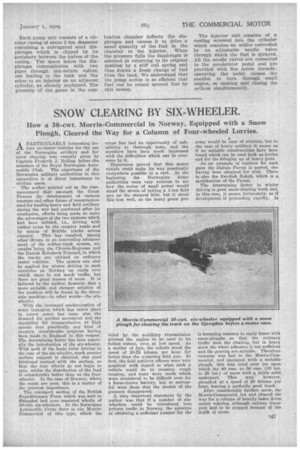SNOW CLEARING BY SIX-WHEELER.
Page 47

If you've noticed an error in this article please click here to report it so we can fix it.
How a 30-cwt. Morris-Commercial in Norway, Equipped with a Snow Plough, Cleared the Way for a Column of Four-wheeled Lorries.
A PARTICULARLY interesting lec ture on motor 'vehicles for the use of the Norwegian artillery and for snow clearing was recently given by Captain Frederik J. Bolling before the members of the Royal Norwegian Automobile Club. The experience of the Norwegian military authorities in this connection is of direct importance to civilian users.
The author pointed out at the commencement that amongst the Great Powers the development of various tractors and other forms of construction used for hauling heavy and field artillery during the war had continued after its conclusion, efforts being made to unite the advantages of the two systems which had been utilized, i.e., driving with rubber tyres an the country roads and by means of flexible tracks across country. This has resulted, among other things, in an interesting advancement of the rubber-track system, examples. being the Citran-Kegresse and the Danish Kornbeck-Triangel, in which the tracks are utilized on ordinary motor vehicles. The system can also be applied for winter driving in such countries as Norway on roads over which there is not much traffic, but there are great masses of snow. It is believed by the author, however, that a more suitable and cheaper solution of the problem will be found in the three. axle machine—in other words—the sixwheeler.
With the increased mechanization of army transport which has taken place in recent years has come also the demand for quicker movement and the capability for transportation at high speeds over practically any kind of country, considerable progress having been made in England in this respect. The determining factor has been especially the introduction of the six-wheeler. With both of the bogie axles driving in the case of the six-wheeler, much greater surface support is obtained, also good frictional contact with the surface, so that the rear wheels do not begin to spin, whilst the distribution of the load is considerably better than on the fourwheeler. In the case of Norway, where the roads are poor, this is a matter of the greatest importance.
The transport section of the British Expeditionary Force which was sent to Shlinghai last year consisted wholly of 30-cwt. six-wbeelers. In the Norwegian Automobile Corps there is one MorrisCommercial of this type, which the corps has had an opportunity of submitting to thorough tests, and the members have been much impressed with the difficulties which can be overcome by it.
Experience proved that this motor vehicle could make its way practically everywhere possible to a cart. At the beginning the Norwegian Army authorities were very anxious to see how the motor of small power would stand the strain of towing a 1-ton field gun up the steepest hills, but it stood this test well, as the many gears pro vided by the auxiliary transmission allowed the engine to be used to its fullest extent, even at low speed. As a matter of fact, the vehicle stood the speed of 20-25 kiloms. per hour far better than the unsprung field gun. At first, the field artillery officers were very sceptical with regard to what such a vehicle could do in crossing rough country, and tests were made which were considered to be difficult even for a horse-drawn battery, but so successful were these that the doubts of the gunners disappeared: A very important statement by the author was that if a number of sixwheelers could be introduced. into private traffic in Norway, the qUestiou of obtaining a sufficient number for the army would be easy of solution, but in the case of heavy artillery it seems as if no suitable constructions have been found which can be used both as lorries and for the bringing up of heavy guns.
As an example of tractors for such guns the Italian Pavesi is quoted, one having been obtained for trial. There is also the Swedish Nohab, which is a modification of the Pavesi.
The determining factor in winter driving is good suow-clearing work and, in this ease, it seems, fortunately, as if development-is proceeding rapidly. It is becoming commou to equip buses with snow-ploughs so that the ordinary traffic does the clearing, but in heavy snow the wheel adhesion is not sufficient and the gearing not suitable. Therefore recourse was had to the Morris-Commercial, and equipped with a suitable plough, this was tried over ice upon which. lay 40 ems. to 50 ems. (16 ins. to 20 ins.) of snow with a fairly solid underpart. This was, however, ploughed at a speed of 20 kiloms. per hour. leaving a perfectly good track: After considerable further snow, the Morris-Commercial led and cleared the way for a column of heavily laden 2-ton motor vehicles, although railway transport had to be stopped because of the depth Of snow.
















































